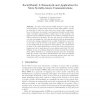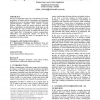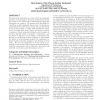CHI
2009
ACM
13 years 10 months ago
2009
ACM
Psychologically preparing for upcoming events can be a difficult task, particularly when switching social contexts, e.g., from office work to a family event. To help with such tra...
SOCINFO
2010
13 years 10 months ago
2010
As online social networks (OSN) attempt to mimic real life social networks, we have made progress towards using OSNs to provide us with data to allow for richer and more robust onl...
COMSWARE
2008
IEEE
14 years 2 months ago
2008
IEEE
Social networks refer to structures made of nodes that represent people or other entities embedded in a social context, and whose edges represent interaction between entities. Typi...
CIKM
2008
Springer
14 years 2 months ago
2008
Springer
The ability to utilize and benefit from today's explosion of social media sites depends on providing tools that allow users to productively participate. In order to participa...
GROUP
2007
ACM
14 years 4 months ago
2007
ACM
The paper systematically explores the social dimension of external interruptions of human activities. Interruptions and interruption handling are key issues in human-computer inte...
DALT
2004
Springer
14 years 5 months ago
2004
Springer
The concept of a social norm is used in multi-agent systems to specify behaviours required of agents interacting in a given social context. We describe a method for specifying soci...
NORDICHI
2006
ACM
14 years 6 months ago
2006
ACM
In this paper we want to reconsider the role anthropology (both its theory and methods) can play within HCI research. One of the areas anthropologists can contribute to here is to...
MM
2006
ACM
14 years 6 months ago
2006
ACM
Personal media collections are often viewed and managed along the social dimension, the places we spend time at and the people we see, thus tools for extracting and using this inf...
ACMDIS
2006
ACM
14 years 6 months ago
2006
ACM
Designers generally agree that understanding the context of use is important in designing products. However, technologically advanced products such as personal robots engender com...
ICSM
2007
IEEE
14 years 6 months ago
2007
IEEE
Software maintenance is a highly collaborative activity whose social context is rarely addressed. To explore this context, we conducted an ethnographic study at a large technology...



